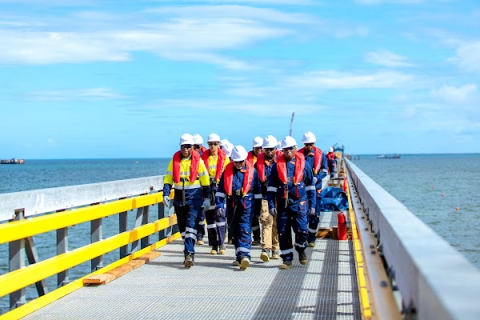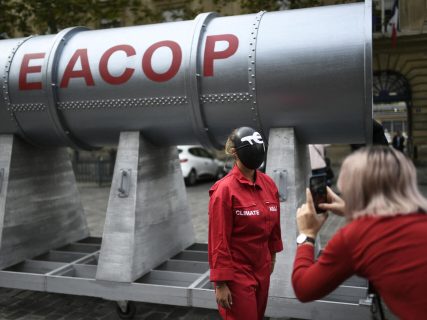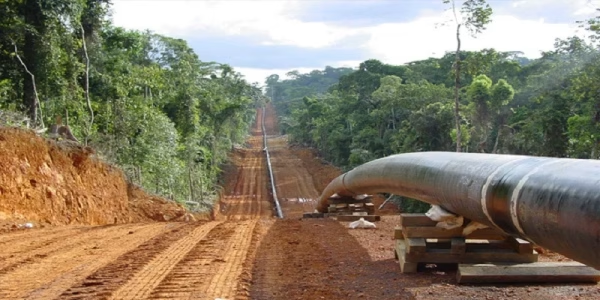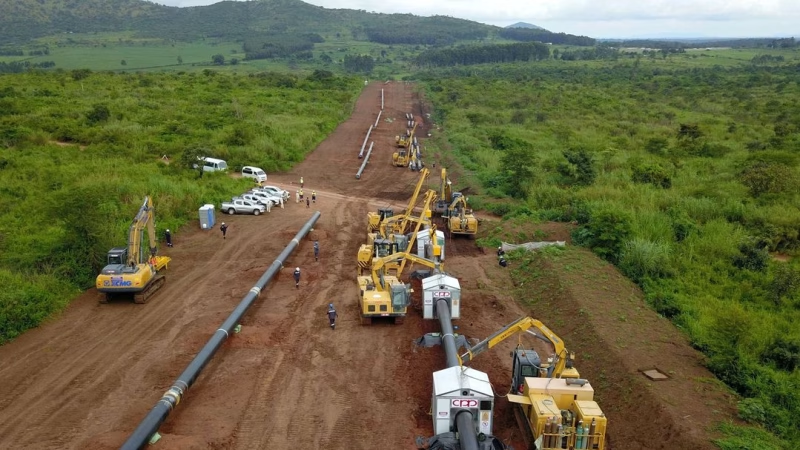Updated October 13, 2025: The East African Crude Oil Pipeline (EACOP) is on track for completion by July next year according to TPDC. The board’s chairman ambassador, Ombeni Sefue, noted that the project had successfully overcome major challenges that once threatened its completion. Moreover, he noted that the project had successfully weathered a sustained campaign by activists. Many of them sought to discourage international financial institutions from funding the project. He also explained that the antiEACOP campaign, which targeted global financiers with claims of environmental risks, aimed to block funding and delay implementation of the project.
July 30, 2025: “I can assure you that despite the opposition, the project has secured full financing and remains firmly on track for completion by July next year,” he added. The remarks were noted during a briefing at the Chongoleani Pipeline Terminal. The terminal is the endpoint of the 1,443-kilometer pipeline project from Kabaale, Uganda. According to Ambassador Sefue, the pipeline project has reached 70 per cent completion, with 65.6 per cent of the welding, equivalent to 946 kilometres, already finished. “The pace of implementation is encouraging and we are confident that Tanzania will soon host one of the most advanced oil export terminals in Africa,” he said.

The East African Crude Oil Pipeline (EACOP) is a 1,443-kilometer pipeline project designed for the transportation of up to 216,000 barrels of oil per day from Uganda’s Lake Albert oilfields to Tanzania’s port city of Tanga. The pipeline, led by TotalEnergies alongside CNOOC International, will be linked to the development of the Tilenga and Kingfisher fields.
The government of Tanzania has directed the EACOP company to accelerate the rollout of community services projects and finance them adequately. The Directive was given by the Deputy Permanent Secretary in the Ministry of Energy, Dr. James Mataragio, during an inspection tour of Geita Region.
Since its initial approval in early 2022, the cost of the project has increased by more than $1.2 billion. Though a major regional infrastructure undertaking, EACOP has been controversial in land acquisition, environmental risk, and climatic considerations. Litigation and campaigns to discourage banks and insurers to finance the undertaking have also led to the project’s setbacks. Despite its controversies, EACOP is expected to have an impact closely similar to the Morocoo-Nigeria gas pipeline project. Its completion will enable various countries and their residents to benefit economically and improve their livelihoods.

The pipeline, set to stretch nearly 6,000 km across West Africa, is designed to enhance regional energy access. Furthermore, it will provide a secure link for Nigerian gas to reach Europe. Technical studies completed in 2025 were said to have confirmed the pipeline’s route. The monumental project is engineered to transport between 15 and 30 billion cubic meters of gas per year and serving 13 West African coastal states. Moreover, it is expected to benefit approximately 400 million people. Internal domestic connections will also link landlocked countries like Niger, Burkina Faso, and Mali to the main line.
Also read:
$5 Billion EACOP Funding to be Supported by Standard Bank
Project Factsheet
Significance:
- Develops the economies of Uganda and Tanzania through increased tax revenues and oil revenues.
- Offers jobs, enhances infrastructure, and promotes national content development.
- Enhances regional integration to the advantage of Kenya, Zambia, and DR Congo
Infrastructure:
- 1,443-kilometer heated pipeline between Hoima (Uganda) and Tanga (Tanzania).
- Transports 216,000 barrels per day from Tilenga and Kingfisher fields.
- Includes pumping stations, storage terminals, and a marine export terminal.
Developer:
- Led by TotalEnergies with partners CNOOC, Uganda, and governments of Tanzania.
- Managed by EACOP Company Ltd. under regional government management.
Funding:
The cost of the project is said to have risen to $5.6 billion, $1.2 billion more than that of the year 2022. It is financed by equity, loans, and banks such as Standard Bank.
Challenges:
- Scolded for posing environmental, climate, and land risks.
- Legal challenges and global activist campaigns are the threat.
- Funding delays due to ESG pressures and stakeholder pushback.
The Significance of the East African Crude Oil Pipeline (EACOP) Once Completed
The significance of the East African Crude Oil Pipeline is one that outweighs the disadvantages, with instant impact being felt. Firstly, it will significantly influence the economies of Uganda and Tanzania by improving both their tax revenues. It will also facilitate creation of job opportunities, national content, and facilitate new infrastructure. Moreover, it will exacerbate the enhancement of a transport corridor between Uganda and Tanzania. The capital investment of $4 billion associated with the construction of the pipeline is one of the largest.

Actually, it is one of the largest ever inward investments into Uganda and Tanzania. From this, Uganda will be enabled to receive more than $20 billion in crude oil revenues from oil wells. Despite the challenges and opposition, the implementation of the pipeline will not only impact both nations, but also neighbors. Countries such as Kenya, Zambia, and DR Congo will also benefit from the impact of the project.
Also read:

